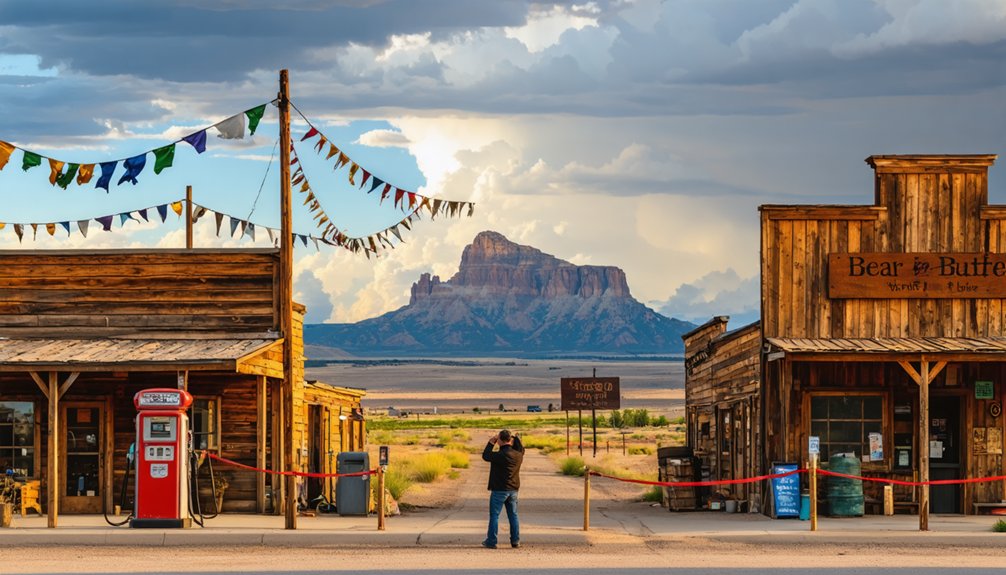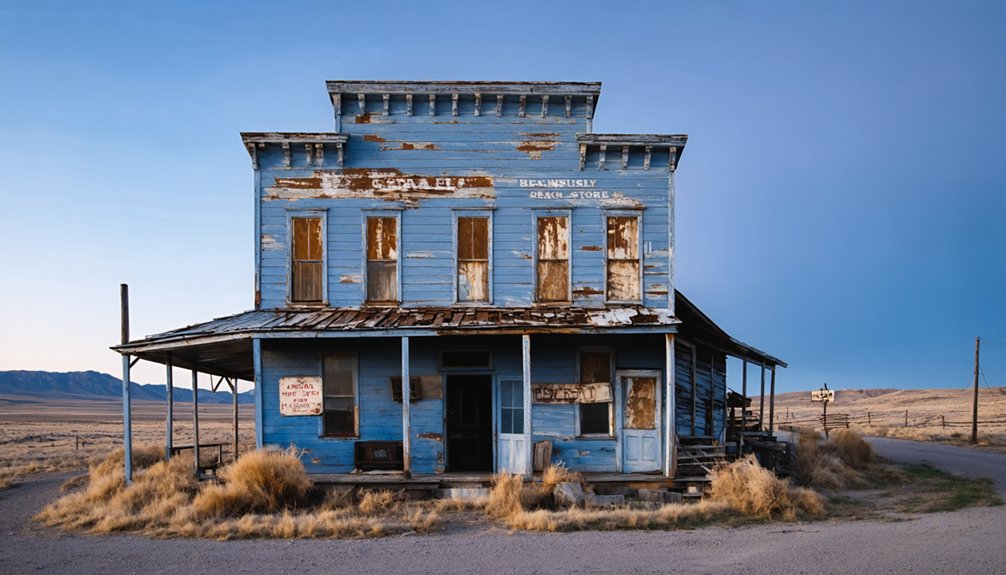You’ll find remnants of 1870s mining settlements surrounding Bear Butte, South Dakota’s sacred 4,426-foot peak. Gold discoveries in 1874 sparked a rush that violated the Fort Laramie Treaty, drawing up to 5,000 residents to establish camps with schools, saloons, and post offices near this ancient ceremonial site. Today, abandoned timber structures and archaeological artifacts from these ghost towns tell stories of boom-and-bust cycles that shaped the region’s complex cultural heritage.
Key Takeaways
- Bear Butte served as a landmark for stage trails connecting mining settlements, leading to numerous ghost towns in the surrounding area.
- Mining camps near Bear Butte flourished during the 1870s gold rush, housing up to 5,000 residents before eventual abandonment.
- The arrival of the Deadwood Central Railroad in 1902 connected settlements but couldn’t prevent their decline as gold deposits diminished.
- Remnants of timber structures destroyed in an 1879 fire provide evidence of once-thriving mining communities around Bear Butte.
- Ghost towns near Bear Butte feature abandoned schools, saloons, and post offices that reflect the boom-and-bust cycle of mining settlements.
The Sacred Mountain’s Ancient Heritage
Rising majestically from the South Dakota plains, Bear Butte has served as a sacred ceremonial site for Native American tribes for over 4,000 years. Known as Mato Paha to the Lakota, this spiritual gateway encompasses all seven sacred elements: land, air, water, rocks, animals, plants, and fire.
Archaeological evidence reveals human activity dating back 10,000 years, with artifacts documenting continuous sacred rituals at the site. The mountain’s spiritual significance is exemplified through the Hanbleceya (Vision Quest), where seekers connect with the divine through meditation and prayer. The landmark achieved recognition as a National Historic Landmark in 1981.
You’ll find traditional offerings like prayer cloths and tobacco ties left by practitioners, maintaining ancient customs. The site’s unbroken religious heritage spans millennia, persisting through settler encroachment and remaining an essential ceremonial center for over 30 tribes today. Notable leaders including Red Cloud and Crazy Horse sought guidance at this sacred mountain.
Gold Rush Impact on Native Lands
When Lieutenant Colonel George Armstrong Custer‘s 1874 expedition confirmed gold in the Black Hills, it triggered a massive influx of settlers that violated the 1868 Fort Laramie Treaty with the Lakota Sioux.
You’ll find that this rush led to systematic land dispossession as prospectors swarmed sacred Native territories, establishing operations like the Homestake Mine that would produce 10% of the world’s gold.
The flood of miners brought devastating cultural erosion to Indigenous communities. Today’s mining claims encompass 271,000 total acres, representing a substantial portion of the Black Hills region. Open pit mining scarred the landscape while cyanide processing poisoned essential water sources like Pactola Reservoir and Rapid Creek. High gold prices continue to drive new mining expansion in the region today.
Mining’s scars run deeper than pits and poisoned waters – they cut through the heart of Indigenous cultural identity.
These waters weren’t just resources – they were integral to Lakota ceremonies and identity.
Though Interior Secretary Haaland’s 2024 mining ban protects 20,500 acres, the damage to Native lands and traditions continues through private mining operations.
From Stage Trail to Ghost Towns
Along the rugged terrain surrounding Bear Butte, stage trails carved crucial transportation arteries that would shape the region’s destiny from 1874 to 1900.
You’ll find these stage routes once connected bustling mining camps like Galena to essential supply lines, while Bear Butte served as the region’s primary navigation landmark.
As gold fever intensified, settlement conflicts erupted between Native Americans and newcomers streaming across traditional tribal lands. The 1868 Treaty of Laramie had originally protected these lands for indigenous tribes before the discovery of gold led to widespread violations.
Mining towns sprouted rapidly, complete with schools, saloons, and post offices. Yet their prosperity proved fleeting – when gold deposits dwindled, residents abandoned their claims and moved on.
Today, you can explore these ghost towns where deteriorating structures stand as silent witnesses to the boom-and-bust cycle.
While the stage trails have vanished, Bear Butte remains a sacred site for indigenous peoples who’ve maintained their spiritual connections despite the area’s dramatic transformations.
In 1902, the arrival of the Deadwood Central Railroad connected these remote settlements to larger markets, though it couldn’t prevent their eventual decline.
Preserving Cultural Legacy
Throughout Bear Butte‘s 10,000-year history as a sacred site, preservation efforts have focused on protecting both tangible artifacts and living cultural traditions.
You’ll find evidence of indigenous resilience in the continuous ceremonies and pilgrimages that have persisted since pre-colonial times, with leaders like Red Cloud and Crazy Horse maintaining these sacred connections.
Cultural preservation gained official recognition when Bear Butte became a State Park in 1961 and a National Historic Landmark in 1981.
Like the thorough documentation methods of Black Hills historians Watson Parker and Hugh Lambert, tribal members meticulously preserve their stories and cultural heritage.
Despite the violation of the 1868 Fort Laramie Treaty, which originally protected tribal rights to these lands, Native communities continue their traditional practices here.
Today’s preservation efforts include protecting archaeological artifacts, maintaining dedicated ceremonial areas, and documenting the site’s complex history through collaborative stewardship between tribal members and local supporters.
The mountain’s landscape was dramatically altered when the 1996 fire destroyed 90% of its vegetation, yet this has not diminished its spiritual significance to Native peoples.
Mining Settlements and Their Remnants
As you explore Bear Butte’s mining settlements from the 1870s, you’ll find evidence of hastily constructed camps that housed up to 5,000 residents during peak gold production worth $1.5 million.
You can trace the ruins of early ore processing equipment, including the short-lived Blake Crusher and Bolthoff Ball Pulverizer that operated for just one year before being dismantled.
The harsh realities of camp life emerge through remnants of timber structures destroyed in the 1879 fire, while miners’ unions formed to address difficult working conditions and low wages in Bear Butte and neighboring communities.
The area holds deep significance as a sacred Cheyenne site where indigenous ceremonies have been performed for generations.
Mining Camp Living Conditions
Life in Bear Butte’s mining camps presented stark realities of frontier existence, where settlers constructed makeshift shelters from available wilderness materials like dirt and logs.
You’d find housing challenges like dugouts and basic log cabins scattered across the rugged terrain, reflecting the transient nature of mining life. James Conzette built the first cabin in 1876. By 1877, nearby Galena had grown to 75 homes housing 400 residents.
Community dynamics centered around essential gathering spots – saloons, boarding houses, and shops where you could find brief respite from the harsh conditions.
With only 25 women among Galena’s 275 residents in 1877, the male-dominated population faced daily struggles with poor sanitation, contaminated water, and limited medical care.
The camps’ opera houses and unions emerged as symbols of residents seeking to build more permanent communities despite the difficult circumstances.
Gold Rush Settlement Patterns
When the 1874 Custer Expedition confirmed gold deposits near Custer, SD, prospectors quickly flooded the Black Hills despite the land’s legal designation under the 1868 Sioux Treaty.
You’ll find that initial gold discovery centered around French Creek, but by late 1875, mining expansion shifted north to Whitewood Creek as richer deposits emerged.
The rush created a network of hastily built settlements along gold-bearing creeks, with boomtowns like Deadwood growing from scattered camps into bustling communities of 7,000+ residents within months.
Most mining districts clustered within a few square miles of Lead and Deadwood, where operations ranged from surface placer mining to deep underground excavation.
Towns competed fiercely for resources, with local newspapers trumpeting exaggerated claims to attract miners and merchants to their settlements.
Abandoned Equipment and Structures
Today you’ll find remnants of steam-powered machinery scattered across Bear Butte’s abandoned mining sites, with rusted boilers and weathered equipment bases marking the locations of late 19th-century operations.
You’ll spot fragments of ore processing machinery, mine carts, and rails amid the ruins of wooden headframes and processing mills.
As you explore deeper, you’ll discover the ruins of boiler houses and miners’ cabins built from local timber.
Water management systems, including old flumes and ditches that once supplied steam boilers, crisscross the landscape.
While many structural remnants have deteriorated due to flooding and humidity, some abandoned machinery still stands as evidence of the area’s mining heritage, though environmental cleanup efforts have removed or capped numerous hazardous sites, particularly around the Gilt Edge Mine.
Modern Balance of Tourism and Spirituality

As you explore Bear Butte today, you’ll find designated trails and viewing areas that maintain a 100-foot minimum distance from active ceremonial sites.
Tourism management includes a permit system for groups over 25 people and requires signed acknowledgments about respecting prayer bundles and sacred objects.
Park rangers monitor visitor compliance with cultural preservation rules through daily patrols and strategic placement of interpretive signs marking restricted zones.
Sacred Spaces Access Rules
The delicate balance between preserving Bear Butte’s spiritual sanctity and accommodating tourism has led to specific access protocols at this sacred Native American site.
You’ll find clear visitor etiquette guidelines designed to protect ceremonial activities while allowing respectful exploration.
When you visit, you’re required to maintain distance from prayer cloths and tobacco ties, leaving all religious offerings undisturbed. You won’t need to pay entrance fees if you’re conducting spiritual practices.
The on-site education center provides essential context about Bear Butte’s significance to the Lakota, Dakota, and Cheyenne peoples.
Park regulations enforce these protocols year-round, with extra measures during summer ceremonies.
You’ll notice posted signage reminding visitors to minimize noise and maintain a reverent atmosphere throughout this ancient spiritual landmark.
Tourism Impact Prevention Measures
Modern preservation efforts at Bear Butte integrate economic incentives with visitor management protocols, generating $5.1 billion in state tourism revenue while protecting sacred spaces.
You’ll find designated trails and limited parking areas that prevent overcrowding, while boardwalks minimize soil erosion and ecological damage.
Cultural education programs feature Native-led tours and interpretive signage that explain Bear Butte’s spiritual significance.
You’re encouraged to participate in authorized cultural events, which generated $312 million in direct spending last year.
The site’s adaptive management system responds to ongoing impact assessments, with restricted access to sensitive areas during ceremonial periods.
Tourism tax revenues of $399 million fund conservation efforts, while visitor quotas and infrastructure investments guarantee you can explore without compromising the site’s sacred character.
Frequently Asked Questions
Are There Any Dangerous Wildlife Encounters Reported at Bear Butte?
You’ll find limited reports of dangerous wildlife encounters, with only documented rattlesnake warnings. There’s no record of bear encounters, though wildlife safety measures encourage staying on marked trails to avoid risks.
What Restaurants and Lodging Options Are Available Near Bear Butte?
Where there’s food, there’s a way! You’ll find local cuisine at The Knuckle Saloon, Uncle Louie’s, and Sturgis Brewing Company. For accommodation options, try Shortgrass Resort or cozy cottages near Bear Butte Gardens.
Can Visitors Participate in Native American Ceremonies if Invited?
You can participate in ceremonies only with explicit invitation from Indigenous leaders. Proper ceremony etiquette requires following all protocols and demonstrating deep cultural respect for sacred traditions.
What Is the Best Season to Visit Bear Butte?
Like golden prairie waves dancing in crisp air, you’ll find spring (May-June) or fall (September-October) offers the best weather for hiking, fewer crowds, and respect for seasonal Native ceremonies.
Are Metal Detectors or Artifact Collecting Allowed Around Bear Butte?
You can’t use metal detectors or collect artifacts at Bear Butte without written authorization. Metal detecting regulations and artifact preservation guidelines strictly protect this sacred site through state and federal laws.
References
- https://www.southdakotamagazine.com/bear-butte-begeman
- https://www.iaa.uni-rostock.de/forschung/laufende-forschungsprojekte/american-antiquities-prof-mackenthun/landmark-stories/bear-butte-1/
- https://en.wikipedia.org/wiki/Bear_Butte
- https://www.spiritualtravels.info/spiritual-sites-around-the-world/north-america/the-sacred-mountain-of-bear-butte/
- https://www.southdakotamagazine.com/watson-parker-ghost-town-friends
- https://www.youtube.com/watch?v=g_d75rnJCDs
- https://history.sd.gov/preservation/docs/RuralButteMeadeCo.pdf
- https://www.brulepodcast.com/e/a-spiritual-pilgrimage/
- https://www.toursturgis.com/blog/bear-butte
- https://savingplaces.org/stories/sacred-native-american-sites-bear-butte-and-wind-cave



